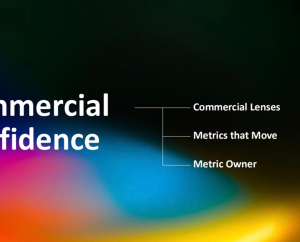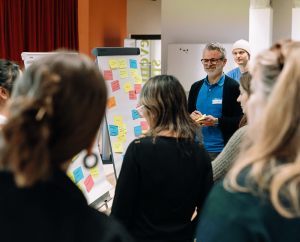Hello to the lovely readers of Design Matters magazine.
I go by the name Kot Bonkers: an independent, self-taught illustrator currently typing this from rainy, slightly grey Vilnius, Lithuania. I’m seated in my one-room apartment in an old brutalist block, surrounded by my three cats and a truly excessive collection of rocks and fossils, scrambling to submit this piece just in time for a burning deadline.

This year has been full of breakthroughs for me, and one of the biggest was facing my debilitating fear of public speaking. To me, it feels a bit like being a prey animal chased through a forest—or, alternatively, like medieval torture. Coincidentally, the lovely organisers of Design Matters 2025 gave me the priceless opportunity to potentially faint on stage in front of hundreds of design professionals in the beautiful city of Copenhagen, all while talking about my creative journey, my craft, and the challenges that come with it—and for that, I am eternally grateful.
We also collaborated on some whimsical drawings for the event, which you might’ve seen on tote bags or printed on the backs of volunteer T-shirts. For approximately two and a half days, I felt like the main character, wandering the city and spotting people wearing items with my little doodles on them. Call it my two minutes of stardom. It almost made up for the fact that all I could afford to eat in Copenhagen was sour-sweet chicken skewers and pineapple from 7-Eleven.

It was also slightly ironic that I was one of the speakers at a digital design conference while being more or less digitally illiterate. Somehow, I even ended up in a prompt battle—without the faintest clue what a “prompt battle” actually was. The excruciating theme we were given was “Alphabet City,” and I was so nervous on stage that, after receiving some vague instructions, all I managed to type as a prompt was: “A baguette store shaped like a baguette.” Luckily, the Wi-Fi cut out just in time, and the audience never saw the incredible results.
Eventually, I went with the unforgettable “Meaty people shaped like letters seen from above in a city, but don’t make them too meaty, they’re not a steak” instead, and unsurprisingly… lost to my opponent.

Talk about a learning curve.
If you’re still reading, you might be wondering: “Will this woman actually ever tell us what her talk was about?”
Fair question. I just really enjoy a drawn-out intro.
1. Intro and early life
Imagine: classic Eastern European post-independence chaos. I’m the oldest daughter, surrounded by addiction, instability, and expectations I never signed up for. The future of my country is on my shoulders. I must learn all the foreign languages perfectly and, overnight, assimilate with Western Europe so my nation can survive. (A lot to ask of a four-year-old.)
Creativity wanders into my life as a form of soft rebellion—a way to build an imaginary world that makes more sense than the one I was born into. It becomes a private portal.

2. Art as a form of self-therapy
In the beginning, it was just me and the paper. No strategy, no audience, no feedback loops. Just a visual diary that was allowed to be raw and weird and emotional and sometimes very ugly, spiteful, human. A place to put the feelings where they couldn’t rot.

3. Online validation and the slow algorithmic death of spontaneity
People start to notice, and I’m suddenly flooded with followers. I become a kind of micro-pseudo-celebrity—with the worst social skills known to humankind.
At first, it felt amazing—especially for a girl who was socialised to be quiet, nice, pretty, and useful. Suddenly I was being seen for something I made, not just for being a beautiful domestic object with good cheekbones.
Somewhere along the way though, I stopped noticing what I wanted to make, and started noticing what worked. I was still drawing, technically—but mostly I was trying to please this invisible, insatiable audience. Some of it real, some of it imagined. I became really good at performing authenticity, while slowly drifting away from myself.

4. The full unravelling
Eventually, I just burnt out completely and had my own 2007 Britney moment. Shaved my head. Shut everything down. I quit.
I got a truly awful graveyard shift job and told myself I deserve to suffer for ruining the one good thing I had. Very dramatic. Very unnecessary. But at the time, it made sense.

5. The slow, boring, unglamorous return
Creativity didn’t come back like a lightning bolt. It returned through living, mostly. Through heartbreaks, dead-end jobs and through learning to be curious about myself.
At some point, I noticed: the more I lived, the more I wanted to make again. But this time, I had questions:
- How compatible is authentic self-exploration with the way we use social media?
- How do our bodies and minds actually want to move—and how does that compare to the pace we’re expected to perform at?
- How compatible is the constant-growth mindset with being a human?

6. Pottery, grandmas, and slightly unhinged healing
Eventually, I started taking pottery classes from a legendary 78-year-old artist named Nora. She was one of the few artists allowed to leave the USSR to show her work abroad, without speaking a word of English. She’s terrifying and brilliant.
We make things in silence, surrounded by Lithuanian grandmas who have absolutely zero interest in Instagram. It’s humbling. Clay will not flatter you.
And being there made me realise: healing doesn’t look like fireworks. It looks like not quitting on yourself, it looks like showing up. Touching the work, letting it change shape with you, even if it stops being impressive. Even if it stops being profitable.

Maybe getting unstuck isn’t about breaking free in one grand gesture.
Maybe it’s about allowing yourself to shift. To rest. To return—not to what worked, but to what feels alive.
And maybe we have to accept that real change usually isn’t graceful or elegant. You, too, will most likely look like some metaphoric creature crawling through dirt on all fours, half-tempted to nap under a tree, half-hoping for a sign. Just figuring it out in real time.
If there’s one thing I took from this whole experience (besides the cost of Copenhagen sandwiches and the palpable realisation that capitalism will end us all), it’s this:
Uncomfortable things are usually the ones worth doing.
There’s real value—and real connection—in radical vulnerability.
So I say: don’t fake it till you make it. Do it while being honest instead. Do it while drenched in sweat. Do it while your palms are so clammy that clapping sounds like a seal at an aquatic show.
Faking is so 2020 anyway.

Get up there and say, “I have no clue what I’m doing. I don’t know the answer. I’m so nervous my heart is racing.” (Unless you’re a heart surgeon. This advice does not apply to heart surgeons.)
Let’s give ourselves permission to make bad art. To make questionable choices. To admit uncertainty. To confess that sometimes we still can’t quite believe we’re adults now. Let’s take a fresh look at how we interact with ourselves—and with our audience. Let’s grant ourselves the right to exist as we actually are.

***
For more Kot Bonkers and her truth illuminating/soul-capturing illustrations, follow her on Instagram @ilovekotbonkers
*All images in this article have been illustrated by the author of the piece, Kot Bonkers.










